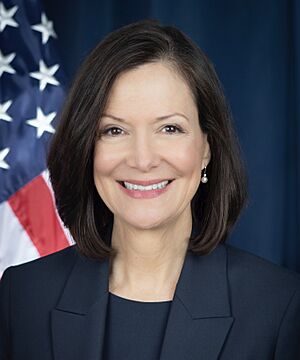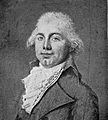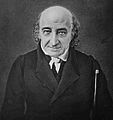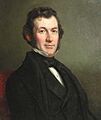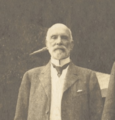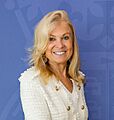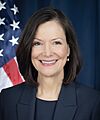List of ambassadors of the United States to France facts for kids
Quick facts for kids Ambassador of the United States of America to FranceAmbassadeur des États-Unis en France |
|
|---|---|
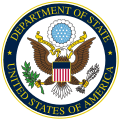
Seal of the United States Department of State
|
|
| Residence | Hôtel de Pontalba |
| Nominator | The President of the United States |
| Appointer | The President
with Senate advice and consent
|
| Inaugural holder | Benjamin Franklin as Envoy |
| Formation | 1778 |
| Website | U.S. Embassy – Paris |
The United States Ambassador to France is a very important person. They are the official representative of the President of the United States in France. Their main job is to help keep a good relationship between the two countries.
The United States and France have been friends for a long time. They started working together during the American Revolution in 1778. At first, the US sent "Ministers" to France. Later, in 1893, the relationship became even more important. That's when the US started sending "Ambassadors." Since 2006, the ambassador to France also represents the US in Monaco.
Contents
What Does an Ambassador Do?
An ambassador is like a chief diplomat. They lead the US Embassy in France. The embassy is like a small piece of American land in France. It helps American citizens and works with the French government.
Building Relationships
A big part of the ambassador's job is to build strong relationships. They meet with French leaders, business people, and regular citizens. This helps both countries understand each other better.
Representing the US
The ambassador speaks for the US President and government. They explain American policies and views to the French. They also report back to the US about what's happening in France.
Helping Americans
The embassy, led by the ambassador, helps Americans in France. This includes things like renewing passports or helping if someone gets into trouble.
A Look Back: US Representatives to France
The relationship between the US and France has a long history. It started even before the US became a fully independent nation.
Early Days: Ministers to the King (1778–1792)
When the United States was new, it sent "Ministers" to France. These were important diplomats, but not yet called "Ambassadors." The first US representative to France was Benjamin Franklin. He was a famous inventor and statesman. He helped get France's support during the American Revolution.
- Benjamin Franklin (1778–1785)
- Thomas Jefferson (1785–1789)
- William Short (1790–1792)
- Gouverneur Morris (1792–1794)
Through Changes: Ministers to the Republics and Empires (1792–1893)
France went through many changes after its own revolution. It had republics, empires, and monarchies. The US continued to send ministers to represent its interests.
One tricky time was during the XYZ Affair in 1797. French officials asked for a bribe before they would talk to US diplomats. This caused a lot of anger and led to a short, undeclared naval war called the Quasi-War. Luckily, relations improved later.
- James Monroe (1794–1796)
- Robert R. Livingston (1801–1804)
- John Armstrong, Jr. (1804–1810)
- Joel Barlow (1811–1812)
- William H. Crawford (1813–1815)
- Albert Gallatin (1815–1823)
- James Brown (1823–1829)
- William Cabell Rives (1829–1832, 1849–1853)
- Edward Livingston (1833–1835)
- Lewis Cass (1836–1842)
- William R. King (1844–1846)
- Richard Rush (1847–1849)
- John Y. Mason (1853–1859)
- Charles J. Faulkner (1860–1861)
- William L. Dayton (1861–1864)
- John Bigelow (1865–1866)
- John Adams Dix (1866–1869)
- Elihu B. Washburne (1869–1877)
- Edward Follansbee Noyes (1877–1881)
- Levi P. Morton (1881–1885)
- Robert Milligan McLane (1885–1889)
- Whitelaw Reid (1889–1892)
- T. Jefferson Coolidge (1892–1893)
Modern Era: Ambassadors to France (1893–Present)
In 1893, the US and France officially started exchanging "Ambassadors." This showed how important their relationship had become. Since then, many notable people have served in this role.
- James B. Eustis (1893–1897)
- Horace Porter (1897–1905)
- Robert Sanderson McCormick (1905–1907)
- Henry White (1907–1909)
- Robert Bacon (1909–1912)
- Myron T. Herrick (1912–1914, 1921–1929)
- William Graves Sharp (1914–1919)
- Hugh Campbell Wallace (1919–1921)
- Walter Evans Edge (1929–1933)
- Jesse I. Straus (1933–1936)
- William Christian Bullitt Jr. (1936–1940)
- William D. Leahy (1940–1942)
- Jefferson Caffery (1944–1949)
- David K. E. Bruce (1949–1952)
- James Clement Dunn (1952–1953)
- C. Douglas Dillon (1953–1957)
- Amory Houghton (1957–1961)
- James M. Gavin (1961–1962)
- Charles E. Bohlen (1962–1968)
- Sargent Shriver (1968–1970)
- Arthur K. Watson (1970–1972)
- John N. Irwin II (1973–1974)
- Kenneth Rush (1974–1977)
- Arthur A. Hartman (1977–1981)
- Evan G. Galbraith (1981–1985)
- Joe M. Rodgers (1985–1989)
- Walter Curley (1989–1993)
- Pamela Harriman (1993–1997)
- Felix Rohatyn (1997–2000)
- Howard H. Leach (2001–2005)
- Craig Roberts Stapleton (2005–2009) - Also ambassador to Monaco.
- Charles Rivkin (2009–2013) - Also ambassador to Monaco.
- Jane D. Hartley (2014–2017) - Also ambassador to Monaco.
- Jamie McCourt (2017–2021) - Also ambassador to Monaco.
- Denise Bauer (2021–present) - The current ambassador, also to Monaco.
Images for kids
See also
- List of French ambassadors to the United States
- Embassy of the United States, Paris
- France – United States relations
- Foreign relations of France
- Ambassadors of the United States


